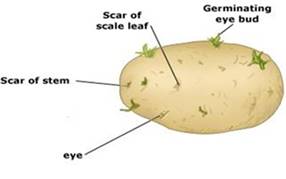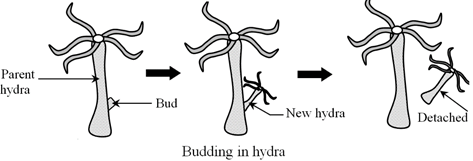Describe the different methods of asexual reproduction. Give examples.
Various methods of asexual reproduction are:
(i) Vegetative propagation: Vegetative propagation is the method of asexual reproduction in which new plants are produced from the vegetative parts of the plant like stems, roots and leaves. Example: Potato

Bryophyllum can be reproduced by vegetative propagation by using either a piece of its stem or leaves. The leaves of a Bryophyllum have special buds on their margins which may fall on the soil and develop into new plant.
(ii) Budding: In budding, specific site of the parent body grows as an outgrowth called bud which then detaches and becomes a new organism. Example, Yeast and Hydra reproduce by budding.

(iii) Fragmentation: In this method, an organism breaks into smaller pieces or fragments which grow into new organisms. This type of reproduction is common in algae. When water and nutrients are available, algae grow and multiply rapidly by fragmentation. An algae break up into two or more fragments which later on grow into new individuals. This process continues and they cover a large area in a short period of time.
(iv) Spore formation: Rhizopus fungus (bread mould) reproduces by spore formation. It is asexual method of reproduction. A spore is a small microscopic structure which is covered by a thick wall to withstand unfavourable condition such as high temperature and low humidity. Thus, spores can survive for a long time. Under favourable conditions, a spore germinates and develops into a new individual. Moss and ferns are reproduce by means of spores.